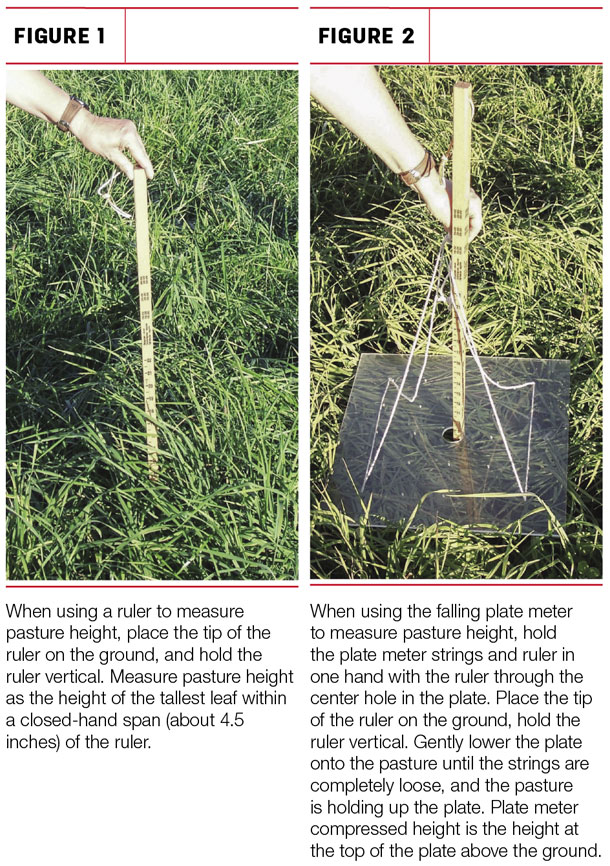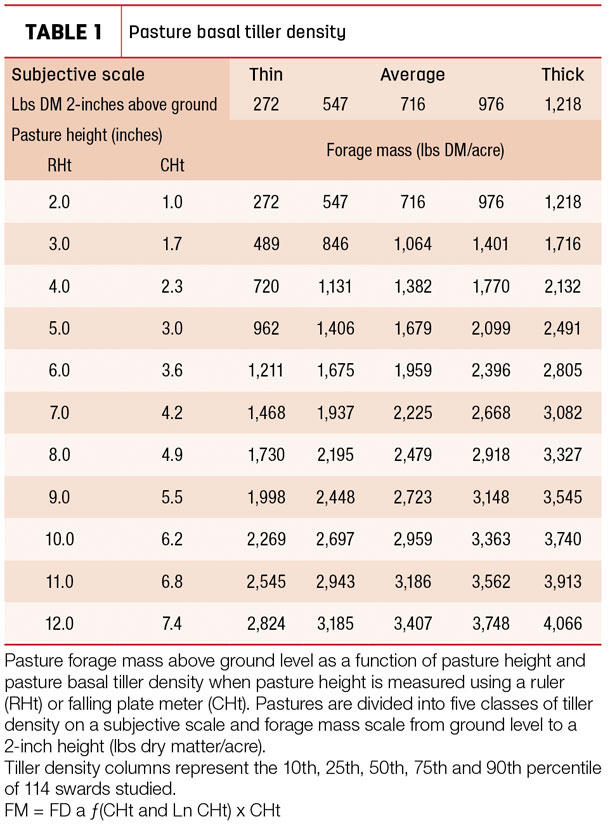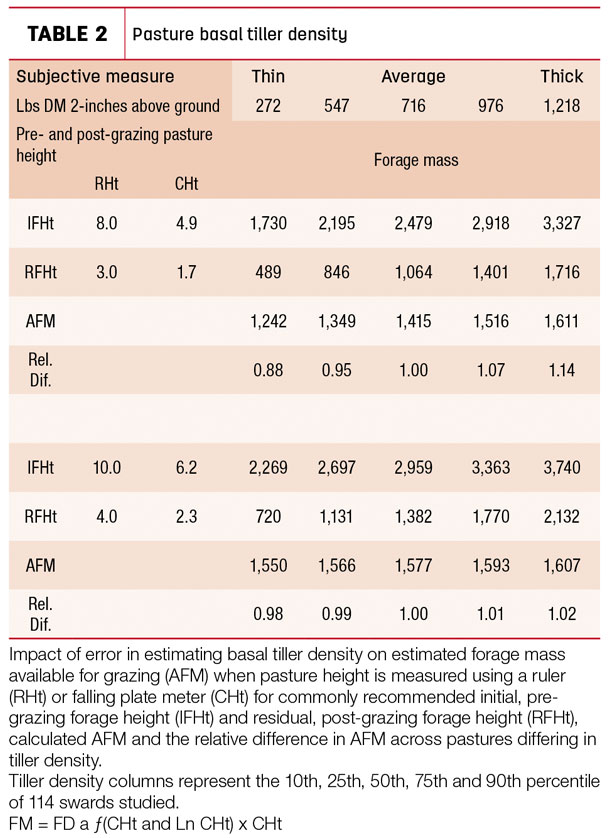To budget pasture use, we need to be able to measure pasture forage mass at turn-in and residual forage mass left at the end of grazing. The difference is the forage available for grazing.
Clipping forage samples is the standard method for research but requires time and effort and is not practical for farm use. Measuring pasture height is easy, and there is a strong correlation between pasture height and forage mass. The key when using height is having a calibration that includes both pre- and post-grazing data across a range of pasture conditions. In evaluating 114 sites of height calibrations in West Virginia and New York, we found a calibration continuum that provides estimates of forage available for grazing within 10 percent of average pastures.
Measuring pasture height
Pasture height can be measured a number of ways. The most common method is measuring pasture height with a ruler (Figure 1).
Another less subjective option is using a falling plate meter that lies on the pasture canopy, compressing it until it supports the entire weight of the plate (Figure 2).

To measure average height, walk the pasture in a zigzag manner to get a good representation of the forage present. Measure and record pasture height at set intervals (every 10 or 20 paces) so that you take 15 to 30 measurements across the pasture. Height measurements should be taken at random at each interval on the path walked. Don’t sample over cow pies or where a thistle plant is present. Use recorded heights to calculate average height in the pasture.
When height measurements are taken and recorded for all pastures every week or two, it is easy to see if pasture growth is excess to animal demand and if a paddock is available for haying or stockpiling for later use. When growth is slow relative to animal demand, it is advisable to provide supplemental feed now to slow pasture use or to ensure adequate stored feed is available for later use.
Estimate pasture tiller density
Forage mass is the product of forage height and density. Pastures differed in basal tiller density due to species composition and prior management. Tiller density is determined by regrowth interval between grazing events and residual plant height at the end of grazing. Both influence tiller size, tiller density and species composition. Long rest intervals tend to produce fewer but larger tillers, suppressing shorter plants in the lower canopy, resulting in lower basal tiller densities. Estimate the pasture tiller density in relative terms as low, medium or high.
a. Low tiller density: aftermath hay meadows and young swards having few but large tillers and not having understory grasses, clover or forbs
b. Medium tiller density: average grass-clover pastures; a mixture of tall fescue, orchardgrass, bluegrass, white and red clover
c. High tiller density: pastures grazed so they look lawnlike in appearance, resulting in the development of high tiller densities
Identify the goal post-grazing pasture height
We also have to specify our goal post-grazing pasture height to balance animal and plant performance. Do we want to maximize animal production per head? Then we need to leave a high residual height. Do we want to optimize herd performance per acre or encourage more legumes in the stand?
Then we need to graze a little closer, but not too close. Pastures tolerate close grazing when the occupation period is short and recovery period is adequately long. Close grazing for a long occupation period is detrimental to stand health. The old saying of “graze half, leave half” is what cattle prefer.
Calculate forage mass available for grazing
Using the average pasture height and estimated density, look up the estimated pre-grazing and post-grazing forage mass from Table 1.

Calculate the forage mass available for grazing by taking pre-grazing forage mass and subtracting post-grazing forage mass.
Little error due to mistaken tiller density
Within recommended pre- and post-grazing heights, an error in estimating basal tiller density has little impact on forage available for grazing (Table 2), with available forage mass differing less than 10 percent from medium tiller density pasture.

When cattle graze 50 percent of forage mass starting at a 10-inch height, the difference between pastures differing in tiller density is only 2 percent.
Pasture budgeting: Balancing feed supply and demand
Pasture budgeting is balancing livestock forage demand to pasture forage supply. We calculated forage supply for grazing using pre- and post-grazing heights. Now we need to estimate forage demand.
An animal unit (AU) is 1,000 pounds live weight of cattle, sheep, goats or horses. On average, when available forage is not limiting intake, these animals have a dry matter intake (DMI) of about 2.5 percent of their bodyweight a day or 25 pounds DMI for one AU day (AUD) of grazing. This ranges from 1.8 to 3.2 percent of bodyweight for beef cattle and 2.5 to 4 percent for lactating dairy cattle. For our example, we will use 25 pounds DMI for one AUD of grazing.
Using an example from Table 2, grazing a medium tiller density pasture from a 10- to 4-inch height, forage supply is 1,577 pounds DM per acre. We calculate AUD per acre as:
(1,577 pounds per acre) / (25 pounds DMI per AUD) = 63.08 or 63 AUD per acre, rounded to nearest AUD.
If the cows weigh 1,250 pounds, we have 1.25 AU per cow (1,250 / 1,000 = 1.25).
We calculate cow days per acre as:
Cow days = (63 AUD per acre) / (1.25 AU per cow) = 50.4 or 50 cow days per acre.
If the pasture is 6 acres in size and we have 60 cows in the herd, the pasture will provide feed for five days of grazing.
6 acres x 50 cow days per acre = 300 cow days / 60 cows in herd = 5 herd days for the pasture.
These estimates of days of grazing apply to paddocks grazed for one to three days. When grazing at lower stocking densities (requiring more days to graze the pasture), grazing efficiency decreases due to animals treading on the forage, and the days achieved will be reduced.
Factors that impact the accuracy of forage budgeting are:
- Cow weight – eyeball versus scale weight
- Cow stage of production – Dry cows eat less than cows in milk.
- Cow body condition – Thin cows eat more than fat cows.
- NDF content in forage – Low NDF (legumes, young grass) increases intake.
- Forage mass below 1,200 pounds DM per acre reduces DMI.
- Crude protein content in forage – Low crude protein reduces intake.
- Long stays decrease grazing efficiency since cattle walk more and tread down forage.
- Most efficient grazing occurs with a one- to three-day grazing stay.
- In wet weather with muddy conditions, trampling losses increase.
Monitoring pasture height is a good tool for helping improve grazing efficiency and is easy to accomplish using a pasture ruler or falling plate meter. ![]()

-
Ed Rayburn
- Forage Agronomist
- West Virginia University
- Email Ed Rayburn








